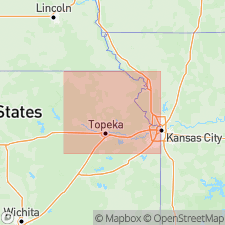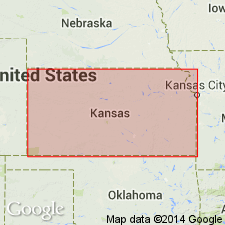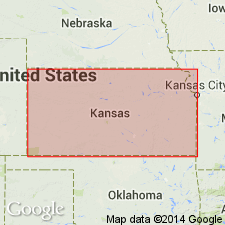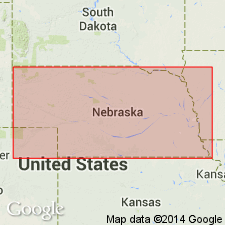
- Usage in publication:
-
- Caneyville limestone
- Modifications:
-
- Revised
- AAPG geologic province:
-
- Cherokee basin
Summary:
Showed Caneyville limestone underlying Pony Creek shale and overlying French Creek shale. Not defined.
See also: R.C. Moore and others, "Stratigraphic section of Pennsylvanian and 'Permian' rocks of Kansas River valley," Kansas Geol. Survey, issued Dec. 1934; R.C. Moore, "Rock formations of Kansas" IN Kansas Geol. Soc. [AAPG 20th Ann. Mtg.], Mar. 21-23, 1935, Wichita, KS, 1935.
Source: US geologic names lexicon (USGS Bull. 896, p. 334); GNC KS-NE Pennsylvanian Corr. Chart, sheet 2, Oct. 1936.

- Usage in publication:
-
- Caneyville limestone
- Modifications:
-
- Original reference
- Dominant lithology:
-
- Limestone
- Shale
- AAPG geologic province:
-
- Cherokee basin
Summary:
Pg. 49, 143, 241. Caneyville limestone of Wabaunsee group. Caneyville limestone is here proposed to include beds from base of limestone previously designated Nebraska City up to top of limestone called Grayhorse. Field studies have shown Nebraska City limestone is a molluscan bed that represents No. 3 phase of a cyclothem for which no fusulinid-bearing, or No. 5 phase, was known until recently, when outcrops in Chautauqua County, Kansas, of this expected phase were discovered. Above this fusulinid-bearing limestone in Chautauqua County is a fragmental, algal and molluscan limestone, that clearly represents the No. 7 phase of this cyclothem. It is traced south into Grayhorse limestone of Osage County, Oklahoma, and it is thus determined that Nebraska City and Grayhorse limestones are parts of a single cyclothem which includes the unnamed fusulinid-bearing limestone between them in southern Kansas. Neither Nebraska City nor Grayhorse is available as a name for the 3 limestones and shales between them. Hence Caneyville is introduced. No name is proposed for the fusulinid-bearing limestone member of the Caneyville, and it is thought that none is needed. The terms Nebraska City and Grayhorse happen to have been introduced and it is perhaps not necessary to kill them. The Nebraska City member of Caneyville limestone is bluish or greenish-gray rather soft sandy limestone that weathers light yellowish-brown, and is 1 to 5 feet thick, averaging 1.5+/- feet. It is basal member of Caneyville limestone. The Grayhorse member of Caneyville limestone is very different in appearance from the other 2 limestone members. It is medium- to coarse-grained; appears fragmental or coquinoid; is rather strongly ferruginous; and thickness averages 1 foot. It lies 5 to 15 feet above the fusulinid-bearing limestones of the Caneyville limestone. Total thickness of Caneyville limestone is 15 to 20 feet. Underlies Pony Creek shale and overlies French Creek shale. Extends from northern Oklahoma across Kansas to southern Nebraska. Age is Late Pennsylvanian (Virgil).
Type locality: in sec. 11, T. 32 S., R. 8 E., Caneyville Twp., Chautauqua Co., KS. Named from Caneyville Twp., Chautauqua Co., southeastern KS.
Source: US geologic names lexicon (USGS Bull. 896, p. 334); GNC KS-NE Pennsylvanian Corr. Chart, sheet 2, Oct. 1936.

- Usage in publication:
-
- Caneyville limestone
- Modifications:
-
- Overview
- AAPG geologic province:
-
- Cherokee basin
Summary:
Pg. 172. See also R.C. Moore and others, 1951, Kansas Geol. Survey Bull. 89, p. 58. Caneyville limestone. Consists of three limestones and separating shales in southern part of outcrop area; two limestones and a shale elsewhere. In northern Kansas where no discernible boundary between Caneyville and Pony Creek is found, strata from base of Nebraska City limestone to base of Brownville limestone are designated [/]Caneyville-Pony Creek, or may be called Wood Siding formation, which is defined by Nebraska Geological Survey to have limits that correspond exactly to Caneyville-Pony Creek. Thickness about 21 feet. Comprises (ascending) Nebraska City limestone member, unnamed shale, limestone, shale sequence, and Grayhorse limestone member. Underlies Pony Creek shale; overlies French Creek shale. Age is Late Pennsylvanian (Virgilian).
[The use of a hyphen between undifferentiated formations is not considered proper notation (CSN, 1933).]
Source: US geologic names lexicon (USGS Bull. 1200, p. 608-609).

- Usage in publication:
-
- Caneyville limestone
- Modifications:
-
- Overview
- AAPG geologic province:
-
- Cherokee basin
Summary:
Pg. 13. In Nebraska Caneyville shale is a poorly defined member of Wood Siding formation; thickness 6 to 10 feet. Underlies Pony Creek shale member with boundary indefinite; overlies Nebraska City limestone member.
Source: US geologic names lexicon (USGS Bull. 1200, p. 608-609).
For more information, please contact Nancy Stamm, Geologic Names Committee Secretary.
Asterisk (*) indicates published by U.S. Geological Survey authors.
"No current usage" (†) implies that a name has been abandoned or has fallen into disuse. Former usage and, if known, replacement name given in parentheses ( ).
Slash (/) indicates name conflicts with nomenclatural guidelines (CSN, 1933; ACSN, 1961, 1970; NACSN, 1983, 2005, 2021). May be explained within brackets ([ ]).

